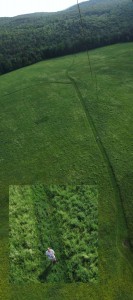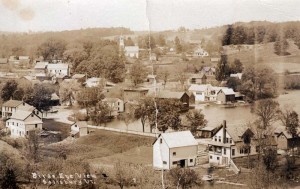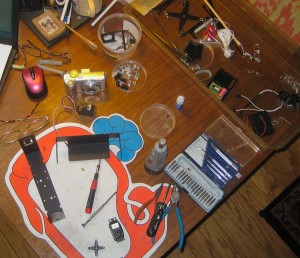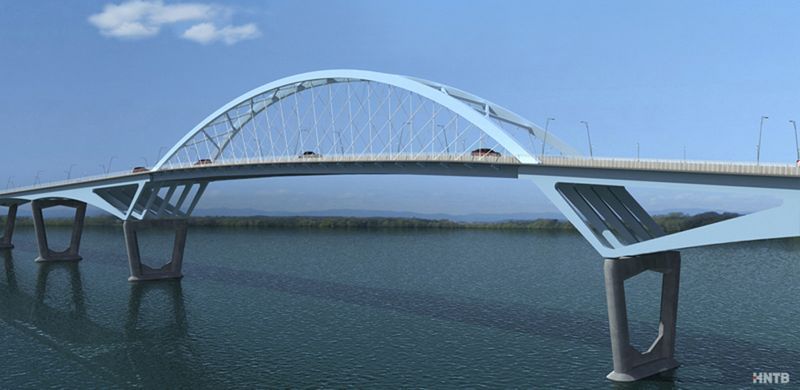I went over to the Adirondacks last Wednesday and came back with 1900 photos. Most of them were taken by my Gigapan imager, and half of those are duplicates that will never again see the light of day. Before I even got to New York, I took 126 handheld photos from the Lake Champlain ferry, 48 of which got stitched into the three-row panorama below of the new Crown Point Bridge, still under construction. Back on August 26, the day the central “network tied arch” was lifted into position, I came to repeat the gigapan I took of the old bridge. But the place was crawling with gawkers, and the men in hard hats would not let me get to the place from which the earlier panorama had been taken. So I left defeated. If you missed it too, you can relive the raising of the arch with the fully archived construction webcams, but you have to click through a lot of photos to get to 3:30 PM on August 26 when the action started. Continue reading “Return to the Nubble”
Category: Photography
Giant Mountain
Somehow I convinced myself that the 4626 foot summit of Giant Mountain in the Adirondacks would be a good place to take some photos with a camera hanging from a kite. Yesterday I walked up there with two kites, three cameras, two KAP rigs, 1000 feet of line, and one sandwich. I think it might be possible to fly a kite up there sometime, but most of the time the wind on a mountain peak is not just blowing horizontally, it is moving up slope. This was obvious when I easily got the delta kite in the air from the summit and it tried to fly into the wind, over my head, and down the slope behind me. I realized that kites are designed to fly in wind that is perpendicular to gravity. When this geometry is lost, erratic behavior results, and the kite landed in a tree twice. Continue reading “Giant Mountain”
Little Tupper #5
Last weekend we made our fifth annual paddle trip to Little Tupper Lake with the same people, the same menu, and (as always) a new campsite. It was the second year we had to take a ferry from VT to NY instead of the Crown Point Bridge which is being replaced. The Photosynth panorama below of the new bridge was stitched from 12 handheld photos taken from the ferry at the dock.
I have made two Picasa albums from the trip. One has photos taken by a small camera attached to a kite line, and the other has photos taken by a DSLR which stayed close to, and more securely above, the lake surface. Below is a slide show from the KAP album. Continue reading “Little Tupper #5”
Bread Loaf

Photosynth Thesis
A couple of weeks ago I took some photos and video from the KAP rig lofted on the Flow Form 16 kite above a clearing behind the house. I did not get far stitching the images into a panorama, and had to move on to other business. Since then I have used Photosynth, which will not only display stitched panoramas, but the multiple unstitched overlapping images. The photos do not need to be taken from the same place, so KAP images should be well suited. Photosynth will create and display a 3D model of the surfaces in the photographs. The model consists of the points that Photosynth has determined are shared in two or more photos, and the 3D plot of those points based on photogrammetric analysis of the images. You can toggle a display of the point cloud in the Photosynth viewer below. Continue reading “Photosynth Thesis”
The final flight of the Fled

Around the turn of the 20th century, a postcard was made with a view of the village of Salisbury, Vermont from a field on the side of a hill. Repeating this photo would highlight the dramatic changes since then, such as the draining of “Mirror Lake,” and the rampant increase in shade trees in the village. But trees also cover the hillside now, so it is not possible to reoccupy the original camera location. I have had this project in mind as I practiced kite photography, wondering how I could fly a camera over the trees close to the proper place. When Friday afternoon arrived sunny and breezy, I hopped in the truck and headed to Farwell Lookoff, the site of an old cabin at the top of that same (now forested) hill. I had been there only once before, and did not remember whether the cabin occupied a large enough clearing from which to launch a kite. The jury is still out on whether it does. Continue reading “The final flight of the Fled”
Built to fly
I awoke this morning to see that not a leaf on the hornbeam was fluttering, and my head fell back to the pillow in dismay. This was a sure sign that I had a new hobby. It was the KAPer’s lament: no wind. I had flown a camera on a kite for two days in a row, and the thought of a calm day was discouraging. But I had started a stitch of yesterday’s aerial panorama before I went to bed, so I got up two hours before Galen had to be at school to check on it.

I built my first KAP rig last week from one of Brooks Leffler’s kits. I have never built anything with servos and dip switches and carbon fiber legs, but I got to use my Dremel tool, so it felt safe. Brooks has designed an elegant system for suspending a camera so that it can point in any direction. The pointing and shutter release are done either at predetermined intervals (autoKAP), or by radio control from the ground. The kit I built had servo motors for both panning and tilting and electronics to automatically point in as many as 76 directions and take photos potentially covering a downward-looking half-spherical view. By replacing the tiny circuit board with a radio receiver, the motors and shutter could be controlled via a transmitter on the ground. It is based on the RC airplane/car/boat/helo standards, so compatible equipment is readily available.
.


